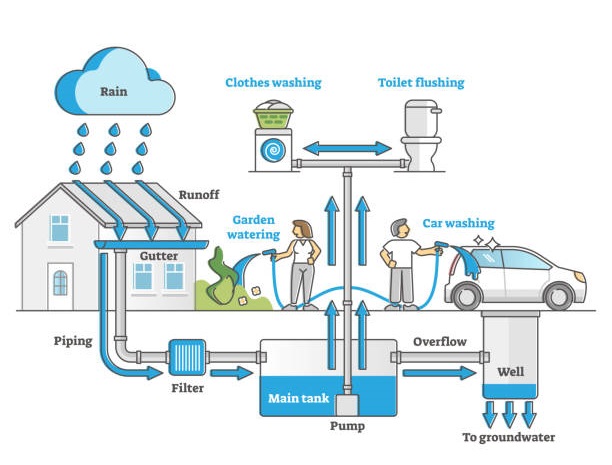What is Rainwater Harvesting and Why is it Important?

Rainwater harvesting as water resource accumulation for home outline concept. Environmental runoff and drain underground piping solution scheme for sustainable collecting and reuse vector illustration
Water is one of the most valuable resources on Earth, yet its availability is shrinking at an alarming rate due to population growth, rapid urbanization, industrial expansion, and climate change. Freshwater scarcity is now a global issue, and in many parts of India, the problem is even more severe. Against this backdrop, rainwater harvesting (RWH) has emerged as a sustainable, cost-effective, and eco-friendly solution to meet rising water demands while conserving natural resources.
In simple terms, rainwater harvesting is the process of collecting, storing, and utilizing rainwater for various purposes such as drinking, irrigation, industrial processes, and groundwater recharge. Instead of allowing rainwater to flow off into drains, rivers, and oceans, rainwater harvesting systems ensure it is captured and put to productive use.
Understanding Rainwater Harvesting
Rainwater harvesting is not a new concept. In fact, ancient civilizations in India, Rome, and Mesopotamia used storage tanks, stepwells, and reservoirs to collect and store rainwater. Today, the method is being revived and modernized to address critical water challenges.
A typical rainwater harvesting system includes:
1. Catchment Area – The surface where rainwater falls (such as rooftops, terraces, or open grounds).
2. Conveyance System – Pipes, gutters, and channels that transport rainwater from the catchment area to storage tanks.
3. Filtration System – Filters that remove debris, leaves, and contaminants.
4. Storage Tanks or Recharge Pits – Reservoirs, sumps, or underground pits that store the harvested water.
5. Distribution System – Pumps and pipelines that supply stored rainwater for use.
Why is Rainwater Harvesting Important?
1. Mitigating Water Scarcity
Many regions in India face acute water shortages, especially during summer. Rainwater harvesting provides an alternative source of freshwater, reducing dependence on groundwater and municipal supply.
2. Groundwater Recharge
Excessive extraction of groundwater has led to falling water tables. By channelling rainwater into recharge pits and borewells, rainwater harvesting helps restore groundwater levels and ensures long-term water sustainability.
3. Reducing Urban Flooding
Cities often face waterlogging and flash floods during heavy rainfall. Harvesting systems reduce surface runoff and direct excess water into storage structures, preventing drainage congestion.
4. Cost Savings
Using harvested rainwater lowers water bills and reduces reliance on costly tanker water. For industries, it cuts down water procurement expenses and promotes sustainable operations.
5. Environmental Benefits
It reduces soil erosion, conserves energy (used in water pumping and distribution), and promotes greener landscapes. It also reduces the carbon footprint of water supply systems.
6. Improved Water Quality
Rainwater, when properly filtered and stored, is free from harmful chemicals often present in groundwater and municipal water. It can be used safely for drinking (with purification), cooking, and household purposes.
Applications of Rainwater Harvesting
It can be applied across sectors:
- Residential Buildings: For drinking, cooking, washing, and gardening.
- Commercial Complexes: To reduce dependency on municipal water.
- Industries: For process water, cooling, and landscaping.
- Institutions & Schools: To provide sustainable water supply and raise awareness among students.
- Agriculture: To irrigate fields and recharge groundwater for farming communities.
Different Methods of Rainwater Harvesting
1. Rooftop Rainwater Harvesting – Rainwater collected from building rooftops and directed to storage tanks or recharge pits.
2. Surface Runoff Harvesting – Capturing runoff from roads, parks, and fields into check dams and ponds.
3. Recharge Pits & Trenches – Small pits filled with gravel and sand that allow rainwater to percolate into the ground.
4. Percolation Tanks – Large structures built to recharge groundwater in rural areas.
5. Rainwater Harvesting for Agriculture – Farm ponds and contour bunding to store water for irrigation.
Government Initiatives and Legal Mandates
In many Indian states, it has been made mandatory for residential, commercial, and industrial establishments. Schemes and subsidies are also offered to encourage its adoption. This reflects the growing recognition of rainwater harvesting as a key tool in water conservation strategies.
Kelvin Water Technologies: Leading the Way in Rainwater Harvesting Solutions
When it comes to professional rainwater harvesting system providers in India, Kelvin Water Technologies Pvt. Ltd. is a trusted name. With years of experience in wastewater treatment, solid waste management, and sustainable water solutions, Kelvin offers customized RWH systems for residential, commercial, and industrial needs.
Why Choose Kelvin Water Technologies?
- Expertise in Design & Engineering: Tailor-made systems based on catchment area, rainfall patterns, and water demand.
- High-Quality Components: Durable filters, tanks, and recharge structures for long-term use.
- End-to-End Solutions: From site survey and system design to installation, maintenance, and after-sales support.
- Environmentally Sustainable Approach: Focused on reducing water stress and promoting green practices.
- Diverse Client Base: Trusted by housing societies, corporate offices, factories, schools, and hospitals across India.
Kelvin Water Technologies not only provides cutting-edge RWH systems but also integrates them with sewage treatment plants , effluent treatment plants, and other water recycling solutions, ensuring a complete water management ecosystem.
Conclusion
Rainwater harvesting is more than just a water-saving technique; it is a necessity in today’s world of increasing water scarcity and environmental challenges. By collecting and reusing rainwater, we can secure our future, reduce dependency on over-exploited groundwater, prevent flooding, and save costs.
With reliable partners like Kelvin Water Technologies Pvt. Ltd., implementing rainwater harvesting system becomes easier, efficient, and highly beneficial. As individuals, communities, and industries, adopting such sustainable practices is a responsibility we must all embrace.